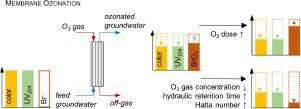Water Research ( IF 11.4 ) Pub Date : 2022-06-11 , DOI: 10.1016/j.watres.2022.118739 Jakob Kämmler 1 , Garyfalia A Zoumpouli 2 , Jörn Sellmann 3 , Y M John Chew 4 , Jannis Wenk 4 , Mathias Ernst 1

|
Membrane ozonation of bromide-containing, high-color natural organic matter (NOM) containing groundwater was performed using single-tube polydimethylsiloxane (PDMS) and multi-tube polytetrafluoroethylene (PTFE) membrane contactors, and compared to batch ozonation. For membrane ozonation, dissolved ozone concentration, water color (VIS436), ultraviolet light absorption (UV254) and bromate formation were correlated with ozone dose, ozone gas concentration, hydraulic retention time and Hatta number (Ha). NOM color removal of up to 45 % for the single-tube contactor and 17 % for the multi-tube contactor were achieved while containing bromate formation below 10 µg L−1. Higher color removal using higher ozone doses was associated with high bromate formation i.e. >>10 µg L−1. In membrane ozonation, low ozone gas concentrations, long hydraulic retention times and high Ha resulted in low dissolved ozone concentrations due to quenching of ozone by NOM. At specific ozone doses of < 0.5 mg O3/mg DOC and Ha > 1, single-tube ozonation resulted in comparable results to batch ozonation while bromate formation was higher in the single-tube contactor at specific ozone doses > 0.5 mg O3/mg DOC and Ha < 1. At comparable ozone doses and Ha, bromate formation in the multi-tube contactor was always higher compared to single-tube and batch ozonation. This could be associated with the uneven ozone distribution within the multi-tube contactor. Results show that ozone dose is the major driver for selectivity between bromate formation and NOM color removal in both membrane and batch ozonation. Bromate formation in membrane ozonation may be controlled by adjusting gas concentration, Ha and hydraulic retention time. Membrane module design and process parameters of membrane ozonation reactors significantly affect treatment performance and should be optimized for selective target compound removal over by-product formation.
中文翻译:

富腐殖质地下水膜臭氧化中溴酸盐的脱色及控制
使用单管聚二甲基硅氧烷 (PDMS) 和多管聚四氟乙烯 (PTFE) 膜接触器对含溴化物、高颜色天然有机物 (NOM) 的地下水进行膜臭氧化,并与分批臭氧化进行比较。对于膜臭氧化,溶解的臭氧浓度、水的颜色 (VIS 436 )、紫外光吸收 (UV 254 ) 和溴酸盐的形成与臭氧剂量、臭氧气体浓度、水力停留时间和哈塔数 (Ha) 相关。在溴酸盐形成量低于 10 µg L -1的情况下,单管接触器的 NOM 颜色去除率高达 45%,多管接触器的 NOM 去除率高达 17%. 使用较高臭氧剂量的较高颜色去除与高溴酸盐形成有关,即>>10 µg L -1。在膜臭氧化中,由于 NOM 对臭氧的猝灭,低臭氧气体浓度、长水力停留时间和高 Ha 导致溶解臭氧浓度低。在 < 0.5 mg O 3 /mg DOC 和 Ha > 1 的特定臭氧剂量下,单管臭氧化产生与批量臭氧化相当的结果,而在特定臭氧剂量 > 0.5 mg O 3的单管接触器中溴酸盐的形成更高/mg DOC 和 Ha < 1。在臭氧剂量和 Ha 相当的情况下,多管接触器中溴酸盐的形成总是高于单管和分批臭氧化。这可能与多管接触器内的不均匀臭氧分布有关。结果表明,臭氧剂量是膜和批量臭氧化中溴酸盐形成和 NOM 颜色去除之间选择性的主要驱动因素。可以通过调节气体浓度、Ha 和水力停留时间来控制膜臭氧化中溴酸盐的形成。膜臭氧化反应器的膜组件设计和工艺参数显着影响处理性能,应针对副产物形成的选择性目标化合物去除进行优化。











































 京公网安备 11010802027423号
京公网安备 11010802027423号